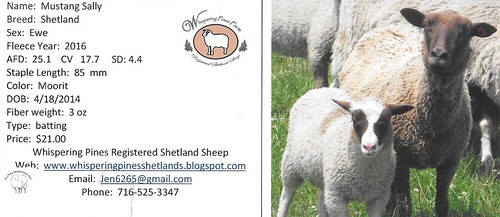Being a handspinner has its perks: you can create the exact yarn you want in terms of fiber content, color, and structure, provided you have the proper skill and materials. If you don't spin, you have to rely on the yarns you find in shops and at fiber festivals, which means that you can't always get your hands on a specific fiber, especially if it happens to be rare. The good news is that yarn producers are starting to get hip to the whole breed-specific thing, and now there are all kinds of unusual yarns and blends available to folks who might otherwise not encounter them outside of a fiber festival.
Over the years I've enjoyed exploring specific breeds of sheep, from Polwarth to Gotland and all points in between. Last year, I purchased some Shetland batts at the Wisconsin Sheep and Wool Festival from Whispering Pines, a small farm in Wisconsin that raises registered Shetland Sheep.
My fiber came with a photo of their sheep and some stats on the specific one who donated their fleece to my project. Her name is Mustang Sally, and she was born on April 18, 2014; I happened to purchase her 2016 fleece, which had a staple length of 85mm (which is approx. 3.3 inches). That's on the longer side for this particular breed of sheep, which averages a staple length of 2-4.5 inches. I still struggle with super short-stapled fibers, so this ended up being the perfect length for me, and the fiber was downy soft - no hint of the hairy undercoat whatsoever!
I felt drawn to this particular breed of sheep after watching a very small and plucky shetland refuse to budge when its handler was trying to lead it out of the stalls to show during a competition at the Wisconsin Sheep & Wool festival. It was hilarious!
These tiny little sheep are hardy, sassy and clearly have some grit - they'd have to, considering their native land is at a similar latitude to Fairbanks, Alaska. The Shetland Isles are even further than the Hebrides and Scotland! Hundreds of islands make up the Shetland isles, and only 15 are inhabited by humans. Only shetland sheep and ponies are brave and hardy enough to inhabit many more of those islands under subarctic conditions.
After washing my finished 2-ply yarn, it because even sproingier and softer than when it had come off the wheel - now I just have to decide what to make with it!
Over the years I've enjoyed exploring specific breeds of sheep, from Polwarth to Gotland and all points in between. Last year, I purchased some Shetland batts at the Wisconsin Sheep and Wool Festival from Whispering Pines, a small farm in Wisconsin that raises registered Shetland Sheep.
My fiber came with a photo of their sheep and some stats on the specific one who donated their fleece to my project. Her name is Mustang Sally, and she was born on April 18, 2014; I happened to purchase her 2016 fleece, which had a staple length of 85mm (which is approx. 3.3 inches). That's on the longer side for this particular breed of sheep, which averages a staple length of 2-4.5 inches. I still struggle with super short-stapled fibers, so this ended up being the perfect length for me, and the fiber was downy soft - no hint of the hairy undercoat whatsoever!
I felt drawn to this particular breed of sheep after watching a very small and plucky shetland refuse to budge when its handler was trying to lead it out of the stalls to show during a competition at the Wisconsin Sheep & Wool festival. It was hilarious!
 |
| Shetland Sheep @ The Wisconsin Sheep & Wool Festival (where it's much warmer!) |
These tiny little sheep are hardy, sassy and clearly have some grit - they'd have to, considering their native land is at a similar latitude to Fairbanks, Alaska. The Shetland Isles are even further than the Hebrides and Scotland! Hundreds of islands make up the Shetland isles, and only 15 are inhabited by humans. Only shetland sheep and ponies are brave and hardy enough to inhabit many more of those islands under subarctic conditions.
After washing my finished 2-ply yarn, it because even sproingier and softer than when it had come off the wheel - now I just have to decide what to make with it!


Comments
Post a Comment